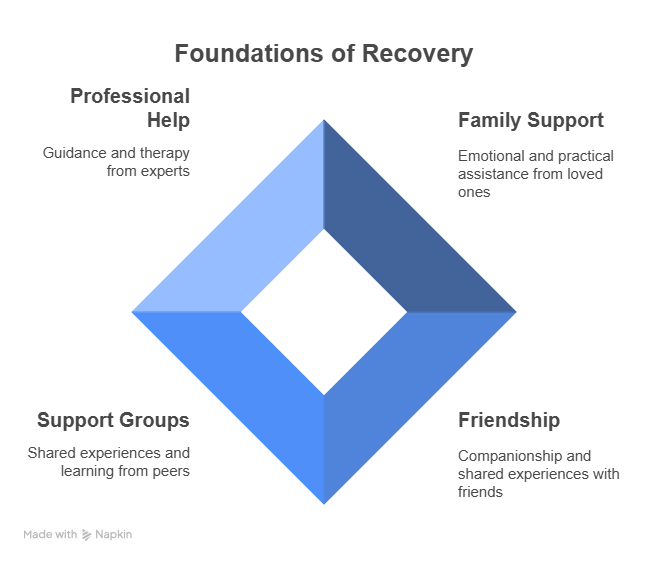Recovery
Overcoming addiction is a journey that can seem impossible, but it’s a path I’ve walked, and I’m here to share my experience. My struggle with fentanyl addiction was a dark period, but it’s become a catalyst for my rebirth.
From hitting rock bottom to finding the strength to overcome my addiction, my story is one of resilience and hope. It’s a journey that has taught me the value of perseverance and the importance of seeking help.
As I reflect on my journey, I realize that recovery is not just about overcoming addiction; it’s about rediscovering oneself. My story is a testament to the human spirit’s capacity to heal and find a new purpose.
Key Takeaways
- Understanding the challenges of fentanyl addiction
- The importance of seeking help and support
- Lessons learned from personal experiences in recovery
- Finding strength in vulnerability
- Rediscovering purpose after overcoming addiction
The Beginning of My Descent
The first time I encountered fentanyl, I had no idea it would change my life forever. It was introduced to me by a friend who was using it for pain management, and I was curious about its effects. Initially, the experience seemed harmless, but it wasn’t long before I found myself drawn back to it repeatedly.
How I First Encountered Fentanyl
I first tried fentanyl during a period when I was struggling with chronic pain. A friend had offered it to me as a solution, and despite initial reservations, I decided to give it a try. The immediate relief it provided was a significant factor in my subsequent use.
- I was introduced to fentanyl by a friend.
- It was initially used for managing chronic pain.
- The immediate relief it provided was a key factor in continued use.
The Rapid Spiral into Addiction
Before long, my use of fentanyl transitioned from occasional to frequent. The rapid development of tolerance and the need for higher doses to achieve the same effect marked the beginning of my descent into addiction. As my dependency grew, so did the negative impacts on my life, including strained relationships and deteriorating health.
- Increased tolerance led to higher doses.
- Frequent use became a daily habit.
- Negative life impacts escalated with continued use.
Hitting Rock Bottom: My Real Fentanyl Recovery Story Begins
The darkest day of my life marked the beginning of my real fentanyl recovery story. It was a day that shattered my denial and forced me to confront the harsh reality of my addiction. As I reflect on that moment, I realize it was the culmination of a series of events that led to my rock bottom.
The Day Everything Changed
I remember the day vividly. It was a moment of intense emotional turmoil, a mix of desperation and hopelessness. The weight of my addiction had become unbearable, and I finally realized that I couldn’t continue down this path. It was a painful awakening, but it was the catalyst for my journey towards recovery.
Facing the Brutal Reality
Confronting the reality of my situation was brutal. I had to acknowledge the damage I had caused to myself and my loved ones. This realization was a difficult pill to swallow, but it was a necessary step towards overcoming fentanyl addiction. It marked the beginning of my acceptance and willingness to seek help.
The Decision to Seek Help
My journey to recovery started with the courageous decision to seek help. This moment marked a significant shift in my approach to battling fentanyl addiction. It was a realization that I couldn’t overcome my addiction alone and that professional help was necessary.
Breaking Through Denial
The first hurdle was breaking through denial. For a long time, I convinced myself that I was in control of my fentanyl use. However, as my addiction worsened, it became impossible to ignore the reality of my situation. Key steps in this process included:
- Acknowledging the severity of my addiction
- Accepting that I needed help
- Letting go of the stigma associated with seeking treatment
Finding the Right Treatment Program
Finding the right treatment program was crucial. I looked for a program that offered a comprehensive approach, including medication-assisted treatment and counseling. I considered factors such as the program’s success rate, the qualifications of the staff, and the support services offered. Ultimately, I found a program that provided the structure and support I needed to begin my recovery journey.
The Physical and Emotional Battle of Withdrawal
My journey through withdrawal was marked by significant physical discomfort and emotional turmoil. The process was a complex challenge that required comprehensive support and strategies to manage both the physical and emotional aspects.
Surviving the Physical Symptoms
The physical symptoms of withdrawal were intense and multifaceted. They included severe muscle pain, insomnia, and gastrointestinal issues. To manage these symptoms, I relied on a combination of medication-assisted treatment and holistic therapies. The medication helped alleviate some of the acute physical discomfort, while therapies like acupuncture and meditation supported my overall well-being.
| Symptom | Management Strategy |
|---|---|
| Severe Muscle Pain | Medication-assisted treatment, Physical therapy |
| Insomnia | Sleep hygiene practices, Relaxation techniques |
| Gastrointestinal Issues | Dietary adjustments, Medication |
Confronting Emotional Demons
Emotionally, the withdrawal process was equally challenging. I faced intense anxiety, depression, and mood swings. To cope with these emotional struggles, I engaged in counseling and support groups. These resources provided a safe space to process my emotions and develop healthier coping mechanisms. Sharing my story and hearing the experiences of others helped me feel less isolated and more supported throughout my personal fentanyl recovery journey.
Tools and Strategies That Saved My Life
The path to sobriety from fentanyl is fraught with challenges, but certain tools and strategies made all the difference for me. Recovery is a highly personal journey, and what worked for me may not work for everyone, but I hope that sharing my experience can provide valuable insights.
Building a Support Network
A crucial element in my recovery was building a robust support network. This included family, friends, and support groups who understood the challenges of fentanyl addiction. Being surrounded by people who cared and were going through similar experiences was incredibly empowering.
- Joining a support group to share experiences and learn from others.
- Reconnecting with family and friends who provided emotional support.
- Seeking professional help from counselors and therapists.

Daily Practices for Staying Clean
In addition to a support network, adopting daily practices was vital for maintaining sobriety. These practices helped me stay focused and avoid triggers.
- Meditation and mindfulness to manage stress.
- Engaging in physical activities like walking or yoga.
- Keeping a journal to track progress and emotions.
By combining these tools and strategies, I was able to navigate the challenges of fentanyl recovery and move towards a healthier, sober life.
Navigating Ongoing Challenges
My journey to recovery was marked by significant hurdles, including dealing with triggers and rebuilding relationships. As I progressed, I realized that overcoming fentanyl addiction is not just about abstaining from the substance but also about rebuilding one’s life.
Navigating these challenges required a multifaceted approach. I had to be vigilant about avoiding triggers and develop strategies to manage cravings.
Dealing with Triggers and Cravings
Triggers can be anything from certain environments to emotional states. I learned to identify mine and developed coping mechanisms, such as mindfulness and seeking support from my network. This proactive approach helped me stay on track.
Rebuilding Trust and Relationships
Rebuilding trust with loved ones was a crucial aspect of my recovery. It involved being transparent about my struggles and consistent in my actions. I made amends where possible and worked on regaining the trust of those I had hurt during my addiction.
| Challenge | Strategy | Outcome |
|---|---|---|
| Triggers and Cravings | Mindfulness and Support Network | Reduced relapse risk |
| Rebuilding Trust | Transparency and Consistency | Improved relationships |
Conclusion: Hope for Others Fighting Fentanyl Addiction
My journey is a real fentanyl recovery story, a testament to the fact that overcoming addiction is possible. Through the darkest moments, I found the strength to seek help and begin the long journey towards healing.
For those struggling with fentanyl addiction, my success story of fentanyl recovery serves as a beacon of hope. It’s a reminder that you are not alone and that recovery is within reach.
Seeking help is the first step towards reclaiming your life. With the right support and treatment, it’s possible to overcome the grip of addiction and build a brighter future.
My story is just one example of the many success stories out there. I hope it inspires you to take that first step towards recovery and a healthier, happier life.
FAQ
What is fentanyl addiction, and how does it develop?
Fentanyl addiction is a condition characterized by the compulsive use of fentanyl despite its negative consequences. It develops through a combination of factors, including initial exposure, rapid tolerance, and the drug’s highly addictive nature.
What are the signs and symptoms of fentanyl addiction?
Signs of fentanyl addiction include increased tolerance, withdrawal symptoms when not using, neglect of responsibilities, and continued use despite physical or mental health issues. Physical symptoms can range from drowsiness and confusion to respiratory depression.
How can I recognize if someone is struggling with fentanyl addiction?
Recognizing fentanyl addiction involves looking for changes in behavior, such as secrecy, mood swings, and withdrawal from social activities. Physical signs like needle marks, drowsiness, or slurred speech can also indicate a problem.
What is the first step in seeking help for fentanyl addiction?
The first step is acknowledging the addiction and accepting the need for help. This is often followed by consulting a healthcare professional to discuss treatment options and create a personalized recovery plan.
What treatment options are available for fentanyl addiction?
Treatment options include medication-assisted therapy (MAT) with medications like methadone or buprenorphine, behavioral therapies such as cognitive-behavioral therapy (CBT), and support groups like Narcotics Anonymous (NA).
How long does fentanyl recovery typically take?
The duration of fentanyl recovery varies significantly among individuals, depending on factors like the severity of addiction, the presence of co-occurring disorders, and the effectiveness of the treatment plan. Recovery is a long-term process that requires ongoing support.
What are some common challenges faced during fentanyl recovery?
Common challenges include managing withdrawal symptoms, dealing with cravings, rebuilding relationships, and coping with triggers. Ongoing support and the right strategies are crucial for overcoming these challenges.
How can I support a loved one in their fentanyl recovery journey?
Supporting a loved one involves being understanding, encouraging their treatment plan, and participating in family therapy if recommended. Educating yourself about fentanyl addiction and recovery can also help you provide more effective support.
Are there resources available for individuals struggling with fentanyl addiction?
Yes, numerous resources are available, including treatment centers, support groups, hotlines, and online resources. Organizations like the Substance Abuse and Mental Health Services Administration (SAMHSA) and the National Institute on Drug Abuse (NIDA) offer valuable information and support.
Can I relapse during fentanyl recovery, and how can I prevent it?
Relapse is a risk during recovery, but it can be minimized by sticking to the treatment plan, attending support groups, and developing healthy coping mechanisms. Recognizing triggers and having a plan to manage them is also crucial
Reference




